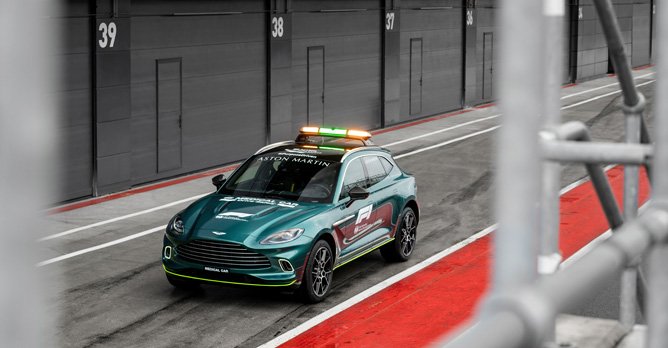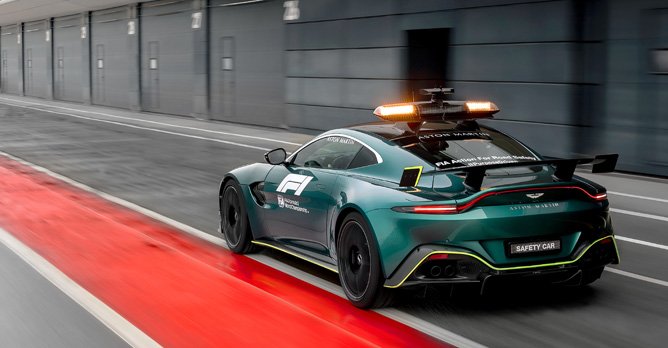Aston Martin Vantage to be Formula One safety car
08 Mar 2021|1,568 views
For the first time in the history of Formula One the official safety and medical cars will bear the famous wings of Aston Martin.
A specially equipped version of the Aston Martin Vantage has been developed for the critical role of intervening and controlling the pace of an event involving the fastest racing cars in the world.
The safety car sees its power has increased by 25bhp to 528bhp, delivered by a 4.0-litre twin-turbo V8. The zero to 96km/h sprint is now dispatched in just 3.5 seconds.
The car's 685Nm of peak torque remains the same but is now sustained for longer, and with additional work on the transmission, allowing the driver a better sense of directness, precision, and control through upshifts and downshifts.
The Vaned grille coupled with a new front splitter creates 155.6kg of downforce at 200km/h, 60kg more than the production Vantage produces at the same speed. Modifications to the suspension, steering and dampers have also been undertaken, with further detailed underbody bracing modifications to increase front structural stiffness. All this, together with a comprehensive aero kit and a switch to lower profile tyres, means the Aston Martin Vantage official F1 safety Car has all the credentials to handle a Formula One circuit.
The Aston Martin DBX meanwhile, will also take on the role of an official medical Car of Formula One, showcasing its own power and handling prowess as it launches into action to support in the event of an emergency.

The official medical car of Formula One is required to carry a substantial amount of equipment including a large medical bag, a defibrillator, two fire extinguishers and a burn kit - and the DBX is more than equipped with 632 litres of boot space.
Whilst the interior trim is fully representative of a customer vehicle, the central rear seat has been removed, and the remaining four have been replaced with sport bucket seats, each equipped with a six-point safety harness. These provide seating for the driver, the FIA Formula One medical response coordinator, as well as a local doctor, leaving one spare, in case an incident requires a racing driver to be driven back to the pit lane.
Much like the safety car, two screens have been mounted onto the dashboard of the DBX to provide live race footage. An additional screen is used to read live biometric data from the drivers' gloves, which in the event of an accident, provides critical information on their condition.
The development of both these cars was carried out by the engineering team at Aston Martin. Both vehicles have endured significant testing, which included high-speed durability assessments and aggressive circuit driving at the Aston Martin facility at Silverstone, totting up almost 15,000km collectively. The vehicles have also been tested in a dyno climate chamber to ensure they will perform in all race conditions.
For the first time in the history of Formula One the official safety and medical cars will bear the famous wings of Aston Martin.
A specially equipped version of the Aston Martin Vantage has been developed for the critical role of intervening and controlling the pace of an event involving the fastest racing cars in the world.
The safety car sees its power has increased by 25bhp to 528bhp, delivered by a 4.0-litre twin-turbo V8. The zero to 96km/h sprint is now dispatched in just 3.5 seconds.
The car's 685Nm of peak torque remains the same but is now sustained for longer, and with additional work on the transmission, allowing the driver a better sense of directness, precision, and control through upshifts and downshifts.
The Vaned grille coupled with a new front splitter creates 155.6kg of downforce at 200km/h, 60kg more than the production Vantage produces at the same speed. Modifications to the suspension, steering and dampers have also been undertaken, with further detailed underbody bracing modifications to increase front structural stiffness. All this, together with a comprehensive aero kit and a switch to lower profile tyres, means the Aston Martin Vantage official F1 safety Car has all the credentials to handle a Formula One circuit.
The Aston Martin DBX meanwhile, will also take on the role of an official medical Car of Formula One, showcasing its own power and handling prowess as it launches into action to support in the event of an emergency.

The official medical car of Formula One is required to carry a substantial amount of equipment including a large medical bag, a defibrillator, two fire extinguishers and a burn kit - and the DBX is more than equipped with 632 litres of boot space.
Whilst the interior trim is fully representative of a customer vehicle, the central rear seat has been removed, and the remaining four have been replaced with sport bucket seats, each equipped with a six-point safety harness. These provide seating for the driver, the FIA Formula One medical response coordinator, as well as a local doctor, leaving one spare, in case an incident requires a racing driver to be driven back to the pit lane.
Much like the safety car, two screens have been mounted onto the dashboard of the DBX to provide live race footage. An additional screen is used to read live biometric data from the drivers' gloves, which in the event of an accident, provides critical information on their condition.
The development of both these cars was carried out by the engineering team at Aston Martin. Both vehicles have endured significant testing, which included high-speed durability assessments and aggressive circuit driving at the Aston Martin facility at Silverstone, totting up almost 15,000km collectively. The vehicles have also been tested in a dyno climate chamber to ensure they will perform in all race conditions.
Latest COE Prices
November 2025 | 2nd BIDDING
NEXT TENDER: 03 Dec 2025
CAT A$109,000
CAT B$129,890
CAT C$76,389
CAT E$125,001
View Full Results Thank You For Your Subscription.






















